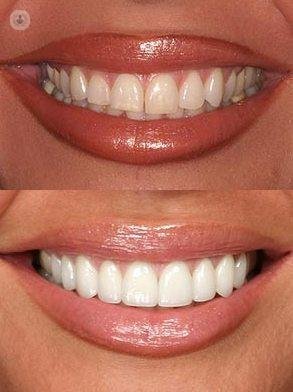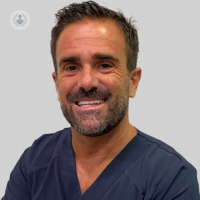Composite veneers, the alternative to correct dental imperfections
Written by:Composite dental veneers are formed by patterned resin layers on the teeth themselves handmade. They serve to cover interdental spaces, correct forms, fractures and tooth size and correct alterations in color. Their advantages allow the patient to enjoy a flawless smile at one sitting.

Composite veneers: what they are
The preparation of composite veneers is performed by placing layers of composite resin which are modeled by hand on the teeth themselves into the desired shape. In addition, the specialist in cosmetic dentistry dentist should be able to give the similarity and mimicry of other teeth, using dyes and colors. All this technique requires great manual dexterity and an artistic part by the specialist to perform completely natural smiles.The resin blends perfectly with the teeth and enamel (hence also the call resin veneers). Also it adapts to them and to the surrounding tissues without problems. The material is very similar to fillings and therefore, the procedure for applying the composite veneering is similar, though not quite the same as the front teeth need a more precise finish and placement technique is more accurate than the fillings for posterior teeth.Composite veneers typically have a thickness ranging between 0.3 and 0.9 mm. This does not need any carved on the original thickness to compensate teeth, which it does with porcelain veneers.
Uses composite veneers
These veneers are often used to correct various types of mild dental problems. The dentist will decide the seriousness of the case and whether it is advisable to use composite veneers or porcelain. Still, its profits are those of any dental veneer:
- Cover interdental spaces- Correct forms, fractures and tooth size- Correct discoloration on teeth
Composite veneers: Are always the most desirable?
Being a simple and fully reversible process, composite veneers are often recommended in children and young patients who have not yet completed their bone development and therefore their dental structure.As a simpler procedure compared with porcelain, composite veneers can be placed in a single session and need not carve the tooth to be placed. This makes it a reversible process, since the original tooth remains the same and, in the future, could withdraw veneers for more innovative treatments.They also have a number of advantages, such as:• It is done in one session• No wear tooth• It is cheaper than treating ceramic veneers• You can change the results once the treatment is completed
Guarantees composite veneers for patients
Depending on the habits of patients, composite veneers typically last between 2 and 5 years and require more attention than porcelain veneers. It is possible that after that time appear some stains on veneers, which are due to external agents, such as coffee, snuff and other products, which can attack the teeth color.In addition to this, we must remember to avoid actions that could damage veneers, like biting hard shells (nuts, for example), cut materials like threads or cellophane ... These are just some of the tips to care for them and extend its duration as possible.The patient should not make special care for their composite veneers, beyond maintaining oral hygiene as if it were normal teeth. Still, it is convenient to visit the expert in Dentistry at least once a year to perform proper maintenance, which may consist of whiten, polish them or file them, among other treatments.
Results composite veneers
Made of composite veneers are an excellent alternative to porcelain veneers in most cosmetic dental treatments alternative, provided that a slightly cheaper and more durable investment you want.
You can get more information at the following link:https://youtu.be/J-pq3JWzgyU
Edited by Patricia Crespo Pujante


